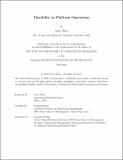Flexibility in Platform Operations
Author(s)
Zhao, Jiayu
DownloadThesis PDF (13.91Mb)
Advisor
Freund, Daniel
Terms of use
Metadata
Show full item recordAbstract
This thesis studies how modern service platforms, through algorithmic and market design, leverage agents’ flexibility to enhance operational efficiency. The last decade has witnessed the booming growth of such platforms in ride-hailing (e.g., Uber), e-commerce (e.g., Amazon), and hospitality (e.g., OpenTable). A central operational challenge in these systems lies in the heterogeneity across both supply and demand. For example, Uber cannot match a rider and a driver who are far apart in time or location. To address such challenges, platforms increasingly rely on flexibility levers—interventions that encourage market participants to be more accommodating in when or how they interact with the platform. For instance, Uber’s ``wait and save'' option offers a discount to riders who are willing to wait longer, making it easier to find compatible matches. Motivated by the growing use of such flexibility incentives, this thesis examines how flexibility can be structured, coordinated, and optimized in modern platforms. It focuses on two central dimensions of flexibility: (1) how flexibility levers interact across a platform’s ecosystem and (2) how flexibility decisions can be optimized to improve operational performance.
Part I of this thesis examines the interactions and implications of platforms' flexibility decisions. Decisions around flexibility on platforms influence both (i) horizontal dynamics across market sides and (ii) vertical dynamics in a supply chain. Chapter 2 investigates the horizontal interaction between demand-side and supply-side flexibility incentives. While such incentives are common on both the demand (e.g., "wait and save" feature at Uber) and the supply side (Ride streak bonuses at Uber) of platforms, they have been treated in isolation in the literature and in practice. Chapter 2 initiates the study of two-sided flexibility in platforms: by modeling how these incentives influence the likelihood of compatibility between agents and the resulting matching size, we study whether and when platforms should invest in flexibility across both market sides. Moreover, we identify that platforms may realize significant efficiency gains by incorporating the horizontal interplay of flexibility when designing different incentives.
In an orthogonal direction, Chapter 3 investigates the vertical supply chain implications of ride-hailing platforms' flexibility decisions. When dual-sourcing autonomous vehicles (AVs) and flexible human drivers with self-scheduling capacity, platforms (e.g., Uber's operations in Phoenix and Austin) make dispatch prioritization decisions to fulfill demand through a hybrid fleet. These decisions affect the incentives of AV suppliers and human drivers, and the self-scheduling nature of gig workers introduces novel supply chain challenges. We study how these challenges can hinder successful AV deployments and provide contracting solutions to overcome them.
Part II of the thesis focuses on optimizing specific operational levers for flexibility. The digitization of modern platforms allows for algorithms that provide better customization and timing to harness flexibility. For instance, booking platforms can adjust their admission control decisions in real-time by considering customers' heterogeneous probabilities of being no-shows (i.e., not requiring service) and their compensation requirements for overbooking. In Chapter 4 we analyze an online resource allocation problem that allows overbooking and propose a policy that improves the additive profit loss guarantee (compared to a clairvoyant) in T periods from an order of square-root-T in the literature to a bounded constant.
A related application appears in e-commerce, where retailers seek to use promotional discounts to align customer demand with their inventory position. Chapter 4 investigates how platforms can leverage an "opaque selling" strategy to dynamically time these discounts to influence purchase behavior and balance inventory. We propose a class of dynamic inventory-balancing algorithms that adapt opaque selling to real-time inventory states, achieving order-optimal fulfillment costs. This chapter demonstrates how demand-side flexibility can be operationalized through pricing levers for better inventory management.
Date issued
2025-05Department
Massachusetts Institute of Technology. Operations Research CenterPublisher
Massachusetts Institute of Technology